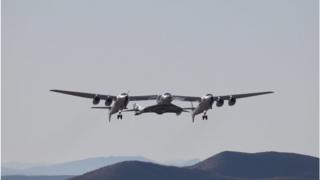Virgin's Unity plane rockets skyward
 Image copyright
VIRGIN GALACTIC
Image copyright
VIRGIN GALACTIC
Virgin Galactic has pushed its rocket plane, Unity, to the edge of space again.
Chief pilot, Scotsman Dave Mackay, and co-pilot, American Mike Masucci, took the vehicle high over California's Mojave Desert, before gliding back down to Earth.
The test flight edges Virgin ever closer to its goal of introducing commercial passenger flights.
More than 700 people are already signed up for a trip to suborbital space.
It's not clear when precisely this service will begin, but Virgin Group boss, Sir Richard Branson, believes it will be very soon.
Friday's mission followed the usual launch procedure.
Unity was carried aloft by the WhiteKnightTwo aircraft, before being released to ignite its rocket motor and climb high over the desert.
It's only the fifth time Unity has conducted a powered ascent, and should have provided valuable data on engine performance and the overall handling of the vehicle.
The big difference with previous flights is that there was a third person onboard. Beth Moses is Virgin's chief astronaut instructor and she was present on the mission to get a better understanding "of the customer cabin and spaceflight environment from the perspective of people in the back".
In December, Unity reached an altitude of 82.7km (271,330ft), which was enough for the pilots on that occasion - Mark Stucky and CJ Sturckow - to earn commercial astronaut wings from the US Federal Aviation Authority.
Sir Richard's Virgin Galactic company is vying with Amazon.com founder Jeff Bezos's Blue Origin outfit to be the first to introduce a sub-orbital passenger spaceflight service.
Mr Bezos is pursuing a different technological route. He has a booster and capsule system that goes straight up from a launch pad in West Texas.
The two components separate at altitude before then both making their way back to Earth under control.
The Amazon entrepreneur's New Shepard system regularly flies over 100km - the height most widely recognised as the lower boundary of space (although there is currently a lively scientific debate over whether this is the best classification).
Jonathan.Amos-INTERNET@bbc.co.uk and follow me on Twitter: @BBCAmos